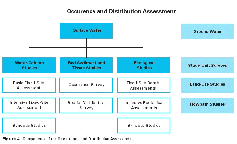I. OCCURRENCE
- A. Study Unit -
- Identify the occurrence of water-quality
conditions that are significant issues.
- B. National Synthesis -
- Identify the occurrence of
water-quality conditions that are regionally and nationally
significant water-quality issues.
II. SPATIAL AND TEMPORAL DISTRIBUTION
- A. Study Unit -
- Characterize the broad-scale
geographic and seasonal distribution of a wide range
of water-quality conditions in relation to natural
factors and human activities.
- B. National Synthesis -
- Characterize and
compare the geographic and
seasonal distribution of selected water-qualtiy
conditions among the broad range of natural and
land-use settings of the
Nation.
III. DESIGN OF STUDIES FOR ASSESSING LONG-TERM TRENDS AND
CHANGES
- A. Study Unit -
- Evaluate Study-Unit
priorities and required study
approaches for effectively assessing long-term trends and
changes.
- B. National Synthesis -
- Work with Study
Units to develop nationally consistent approaches
to assess long-term trends and changes for
priority issues.
IV. PRELIMINARY ASSESSMENT OF SOURCES, TRANSPORT, FATE, AND
EFFECTS
- A. Study Unit -
- For water-quality conditions of greatest
importance, evaluate geographic and seasonal
distributions in
greater detail and in relation to the sources,
transport, fate,
and effects of contaminants. Determine the priorities and
design for followup case studies.
- B. National Synthesis -
- Characterize and compare the
similarities and differences in relations to
sources, transport,
fate, and effects of selected contaminants prioritized for
National Synthesis across the range of natural and
anthropogenic settings of the Nation.
|


